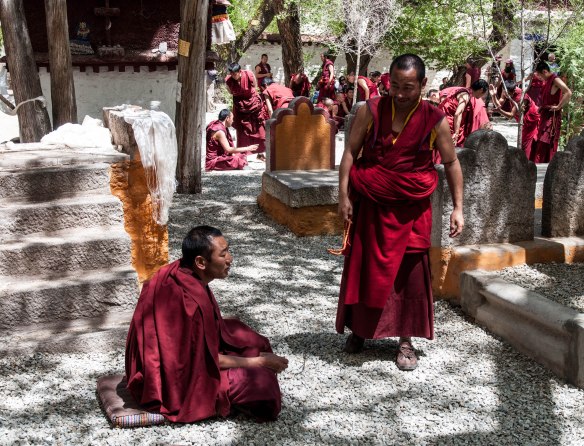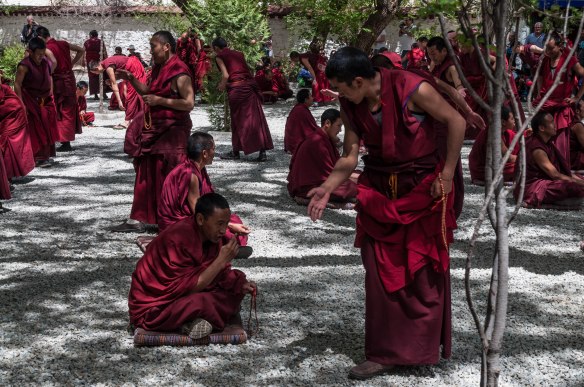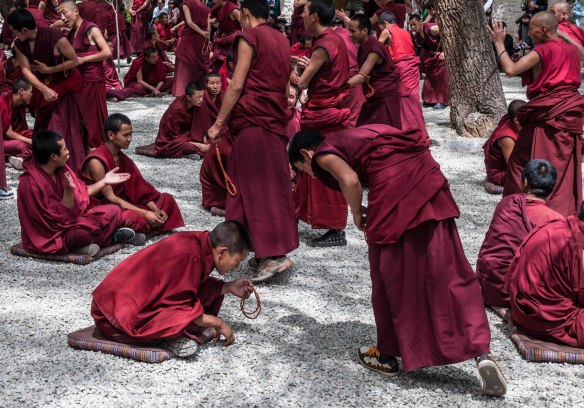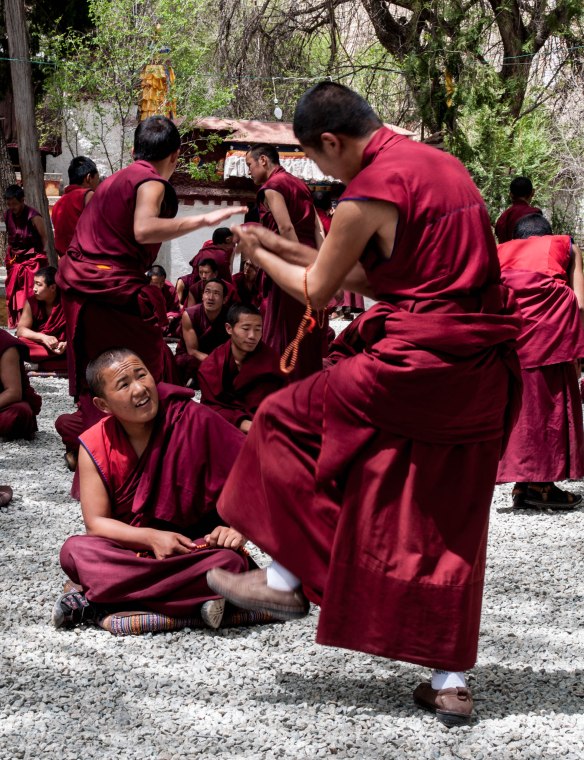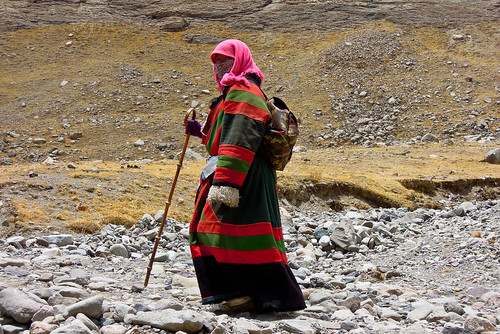
Shudu Lake (蜀都湖 shǔdū hú)
After a pretty restful night at Mr. Tian’s guesthouse, we had a breakfast of instant noodles. We also spent time boiling water and filling our water bottles for the days’ trek. Mr. Tian was amused that we were bringing so much water. We each had about three liters in Platypus water bags. He told us the trek would be about 6-8 hours and we would be climbing up and over a more than 13,000 foot pass.
As we were anxious to get going, Mr. Tian told us how to get to the bridge that crossed the river and where the trail began. He was getting his horse ready when we took off. We planned to wait for him and his party if we were not sure which way to go.
The guesthouse was up on the side of the valley, so we had to wind down through the village to the river. The farmhouses were clustered together with fields of barley between them. As the village was on the slopes of a mountain, many of the fields were terraced. We passed several racks used for drying barley.

Along the way we met an old man taking his pigs out to the pasture for the day. He didn’t speak a word of Chinese, so there was not much communication other than some smiles and waves.

After winding our way through the farmhouses we found the bridge crossing the Niru River.


Niru River bridge
After crossing the bridge the trail passed two large piles of mani stones. We decided to take a break here and wait for Mr. Tian and his clients. Niru Village is in the background. While waiting, the old man with the pigs herded his pigs into a nearby pasture.

photo by Michael Paul

After waiting for awhile, Mr. Tian and his clients showed up. One was a young American guy from Brown University who was doing research on the economic effects of the National Park on Tibetan villages in the area. He had three young Chinese students with him that were serving as research assistants. I believe they were from Yunnan University. The American guy carried a large, cumbersome backpack, but the Chinese guys just had little day packs. The horse carried the rest of their gear. We chatted for a few minutes, then Michael and I took off. We found out very soon that even though the horse was carrying most of their things, they were hiking very slow. Michael and I are both experienced backpackers, so this was nothing new to us.

Looking back at Niru
The trail swithbacked up the side of the mountain for about 2 miles before turning into a side canyon. High up on the mountainside we had a good view of the Nanbao pastures across the valley. It would have been really nice to be able to hike up there, but that will have to wait for a future trip.

Nanbao pastures from across the valley

Turning into the side canyon
The trail up this valley was green and lush. We knew we were headed up to a 13,000 foot pass, but we were having a hard time picturing it with all this lush greenery. Occasionally a Tibetan with pack horses would pass us on the trail. In the Mountain West region of the United States where we live, anything above about 10,500 feet is rocky, barren, and devoid of almost all plant life.


After a couple more miles we came to some small pastures. On the edge of one of these pastures was a log cabin, just like you might see out the Western United States from pioneer times. We decided to take a break here and wait for Mr. Tian and the others. There was a crudely written sign on the front of the cabin saying visitors were welcome to stay there. Mr. Tian later explained to us that there are similar cabins scattered throughout the mountains for yak herders to stay in when the weather turns bad. It did not look like the cabin would keep much out, but I suppose it would be better than being outside in a storm.



The trail soon left the valley and began climbing steeper again. It switchbacked up a steep mountainside to another higher meadow area.

High mountain pasture (about 12,600')
Finally, after about five or six hours of hiking we arrived at the pass. And we were very surprised to find it as lush and green as the surrounding valleys we had passed through earlier. We later learned that in this area of Southwest China there are several long, deep river valleys that run South to North. Warm, moist air and storms from tropical Burma and further south keep these valleys wet and green. Burma was less than 75 miles from here.

A cabin on the pass at 13,057' (3980 m)
We rested here taking in the fine views. Mr. Tian spent some time digging for medicinal roots.

Mr. Tian digging for medicinal roots
Mr. Tian and the others were razzing us for carrying so much water. Ironically, about 2/3 the way up to the pass, they were all out of water, and sheepishly asked us for some fluids. We had a couple bottles of Chinese sports drink that we were able to share with them. Maybe that’s why they were so slow.

A yak hanging out in the cabin at the pass
The trail descended quickly off the pass and back down into the forest. The lower we got the more yaks we began to see. Once we were out of the forest we could see an immense sea of pasture down below us. This was an important Winter pasture area for the Tibetan yak herders.

Hiking down to the pasture
The pasture was huge, stretching for miles in each direction. There were herds of yaks scattered all over the pasture. We learned from our Tibetan driver that most yaks are actually hybrids—a cross between cows and yaks. They seemed pretty docile, just watching us as we walked past. There were also more rustic cabins dotting the area.


On the far side of the pasture we came to a couple log structures that looked like they were intended to be stores, but were deserted, and in a state of disrepair. It was obvious that they had never been used after being built. It seemed as if this area was gearing up for tourism, but the infrastructure was not there, and maybe the tourists had just not shown up yet. There were no roads into this area and anyone wanting to come would have to walk or ride a horse for at least half a day or more.

We asked a local Tibetan if there was anywhere we could buy something to drink. He pointed to a cabin a little ways off with smoke rising from it. We walked over there and entered the cabin (Tibetans do not usually knock). Inside, the cabin was dark and smokey. There were three men and a woman sitting around the fire talking and laughing. The woman jumped up when we entered. Surprisingly, of all things she had for sale, she had cans of Pepsi. We each bought a can and went back out to the other cabins where our packs were. While resting there a couple Tibetan kids wandered over to see the foreigners. They didn’t say much. I don’t think they understood much Chinese, and our Tibetan was much better.


After resting up for a short time, we continued on our way. It was getting late and Mr. Tian told us that there were tourist busses at Shudu Lake that could take us back to the National Park entrance. He believed that the last bus left at 4:00 pm. We really wanted to get on that bus, as we were really hungry now. For the whole day we had subsisted on some coconut cookies, some peanuts, water, and Pepsi. We wanted to get back to Shangri-la and a proper meal.
The trail headed into a nice forest on the far side of the pasture, then began climbing again to a low pass. Once over the pass we could see the lake and pastureland below.


Looking down at Shudu Lake
We hiked pretty fast down the hillside to the marshy pastures below. We wanted to make sure we made that last bus. Once we got down to the pasture below, Mr. Tian unloaded his horse and began to set up camp. He was staying there for the night before returning to Niru the next morning. The pastures around the lake were full of wildflowers, Tibetan horses, and yaks. It was really wet as well. At times we would sink up past our ankles in the wet marshy grass.

Mr. Tian and a Tibetan friend setting up camp


It was a really beautiful and tranquil place. We had a pow-wow and discussed if we could possibly stay there at the meadows for the night. We were also making some contingency plans if we missed the last bus and had to spend the night there. We had warm clothing, but no sleeping bags. We had travel sheets (like a thin cotton sleeping bag), but that would not provide much protection. We also did not have any food. We could certainly survive a night and there were plenty of empty cabins around. We vowed that if we ever returned we would have lightweight camping gear with us, and plenty of food. We would have loved to stay longer and explore the area, but it was not looking like that would be feasible. Our first priority was to head across the long, marshy pasture to the far side where there supposedly was a parking area and tour busses.
The going was laborious as the ground was very wet. The grass was tall in places, and large, dense tufts of grass further slowed us down. The closer we got to the lake, the wetter the ground, but that was also the more direct route to where we needed to go. By the time we got across the pasture we were soaked from the knees down.
There was a large parking area, restrooms, and a visitors center. Fortunately, there were also several large coach busses there waiting. We climbed aboard a bus, relieved that we made it in time. The American young man and his Chinese companions arrived a short time later.
We learned that the way Chinese manage National Parks was quite different than what we were used to in the U.S. These large tour busses took tourists through the park, occasionally stopping at scenic areas where the tourists could get off and look around. Everyone then got back on the bus and rode to the next scenic spot. There were no camp grounds and no private cars. But were Tibetan camps around as this area has been an important yak grazing area for hundreds of years.
When we arrived at the entrance to the park, we were met by park officials who demanded we pay the entrance fee, which we thought was pretty steep for what you got. We were actually hoping we could by-pass the fee as we had entered the park through the back way, but there was no persuading them.
Getting back to Shangri-la was our next objective. Most all the busses were chartered for tourists and did not have room. We finally found a guy with a minivan who, for a price, agreed to take us to Shangri-la. It was about a two hour drive back to the city.
When we got back into town, we found a room at a small hotel, then headed to a nearby restaurant and had a large and satisfying meal of Chinese and Tibetan food. It was a very long day and the end of a very memorable trip. We have plans to return to the area but have not made any definite plans yet. Next time, we will be better prepared.
I hope you have enjoyed reading about this adventure.





















